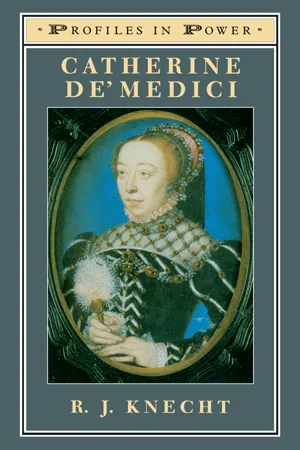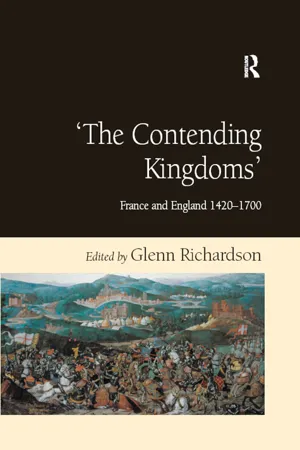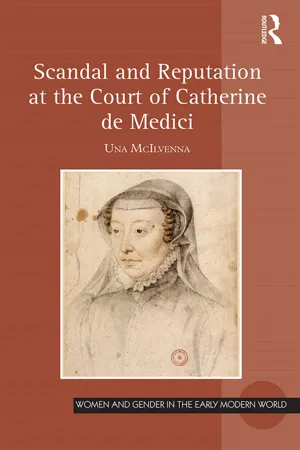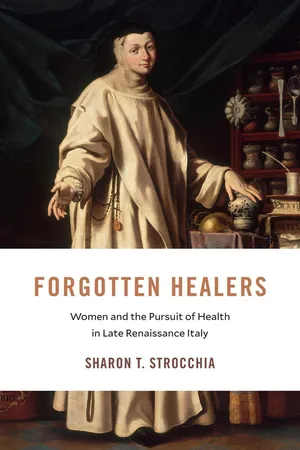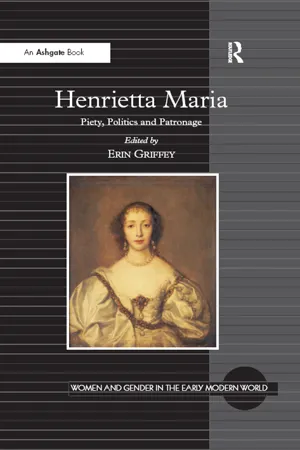Catherine de' Medici
Catherine de' Medici was an influential figure in 16th century France, serving as queen consort and later regent. Known for her political acumen and involvement in the Wars of Religion, she wielded significant power and navigated complex religious and political tensions. Catherine's legacy is marked by her efforts to maintain stability and control during a tumultuous period in French history.
7 Key excerpts on "Catherine de' Medici"
- eBook - ePub
- R J Knecht(Author)
- 2014(Publication Date)
- Routledge(Publisher)
...Chapter 3 QUEEN OF FRANCE (1547–59) Catherine de’ Medici became queen of France at the age of twenty-eight, yet her political influence was minimal during the lifetime of her husband, King Henry II. He looked to others for political advice, notably his mistress, Diane de Poitiers, and his chief minister, Anne de Montmorency. Catherine’s role was essentially to perpetuate the dynasty. Having already produced two children – François and Elisabeth – during Francis I’s reign, she produced eight more during the twelve years of Henry’s reign: Claude, born at Fontainebleau on 12 November 1547; Louis, due d’Orléans, on 3 February 1549 (he died on 24 October 1550); Charles-Maximilien – the future Charles IX – on 27 June 1550; Edouard-Alexandre – the future Henry III – at Fontainebleau on 20 September 1551; Marguerite – the future ‘Reine Margot’ – at Saint-Germain-en-Laye on 14 May 1553; Hercule – the future François, duc d’Anjou – at Fontainebleau on 18 March 1555; and lastly twin daughters, Jeanne and Victoire, on 24 June 1556. According to the Spanish ambassador, Simon Renard, this birth nearly killed Catherine. Victoire lay dead in her womb for six hours and her leg had to be broken to save her mother’s life. Jeanne died seven weeks later. 1 Catherine was a very devoted mother, as is revealed by her correspondence: a high proportion of her earliest letters are addressed to Jean d’Humières, the governor of the royal children. 2 Yet, even if she was excluded from any significant role in state affairs, her future was largely determined by the events of Henry II’s reign. Without entering into all the details of his policies at home and abroad, we must examine certain happenings which shaped Catherine’s destiny.. . . THE PALACE REVOLUTION OF 1547 The death of Francis I was followed by a palace revolution. The forces of faction which had been building up in the last years of the reign were now released...
- eBook - ePub
'The Contending Kingdoms'
France and England 1420–1700
- Glenn Richardson, Glenn Richardson(Authors)
- 2017(Publication Date)
- Routledge(Publisher)
...Chapter 7 Elizabeth I and Catherine de’ Medici Susan Doran An examination of the relationship between Elizabeth I and Catherine de’ Medici might seem an odd, or even inappropriate, topic for a collection of essays on Anglo-French relations inspired by the centenary of the Entente-Cordiale. An objection might be raised that Catherine cannot legitimately be treated as a representative of France as she was neither born nor acted as queen regnant there. Yet, although a native of Florence, Catherine was more French than anything else. She had moved away from Italy in 1533 when she was a young girl of 13; she wrote and spoke French fluently and was imbued with the culture of the Valois court. Furthermore, while never a queen regnant, from the time of her husband’s death in July 1559 until her own in January 1589, Catherine as la reine-mére played a significant role in French political life, influencing both French domestic affairs and international relations. Her voluminous correspondence is testimony to her close involvement in public affairs. The English State Papers, moreover, make clear that Queen Elizabeth and her ambassadors took Catherine very seriously indeed as a major political player, especially during the reigns of her younger sons, Charles IX and Henry III. It is true that during the 17 months when her eldest son, Francis II, was on the throne Catherine’s influence was thought to be limited compared with that of the Guise family, especially Francis, Duke of Guise, and Charles, the cardinal of Lorraine who were the uncles of the new king’s wife, Mary Queen of Scots. Thus, on 11 July 1559, Sir Nicholas Throckmorton, the English ambassador, reported gloomily that ‘the house of Guise is like to govern all about the King, who is much affected towards them’, and two days later he pronounced: ‘The House of Guise ruleth’. Nonetheless, even during this period, Catherine’s importance was acknowledged...
- Una McIlvenna(Author)
- 2016(Publication Date)
- Routledge(Publisher)
...See the catalogue for the 2008 exhibition at the Palazzo Strozzi, Women in Power: Caterina and Maria de’ Medici: The Return to Florence of Two Queens of France, ed. Clarice Innocenti (Firenze: Mandragora, 2008). 36 Sutherland, ‘Catherine de Medici’, 46. 37 Caroline Zum Kolk, ‘Catherine de Médicis et sa maison. La fonction politique de l’hôtel de la reine au XVIe siècle’ (unpublished doctoral thesis, Université Paris VIII, 2006), 23. ‘Les critiques adressées à Catherine de Médicis reprennent des motifs déjà rencontrés dans le cas d’Isabeau de Bavière: l’étrangère qui livre le pays à ses ennemis, la mère dénaturée, avide de pouvoir… la répétition des arguments est frappante. L’archétype de la reine néfaste a pris forme’. 38 Sarah Hanley has written extensively on the fraudulent nature of Salic Law; see ‘Engendering the State’, 4–27. 39 Nicole Cazauran, ed., Discours merveilleux de la vie, actions et deportements de Catherine de Médicis, royne-mère (Genève: Droz, 1995), 155: ‘nonobstant les oppositions d’aucuns des deputez des estats fondées sur l’authorité de nostre loy Salique, et les mauvais succez des gouvernemens des femmes en ce roiaume… le gouvernement est deferé à la Roine’. 40 For the contemporary literary response to the Discours merveilleux, see Yvonne Roberts, ‘The Regency of 1574 in the Discours Merveilleux and in the Poems of Jean-Antoine de Baif’, Bibliothèque d’Humanisme et Renaissance 63, no. 2 (2001): 261–75. 41 Katherine Crawford, Perilous Performances: Gender and Regency in Early Modern France (Cambridge, MA: Harvard University Press, 2004). 42 Discours merveilleux, 170. 43 La Reine Margot, dir...
- eBook - ePub
Forgotten Healers
Women and the Pursuit of Health in Late Renaissance Italy
- Sharon T. Strocchia(Author)
- 2019(Publication Date)
- Harvard University Press(Publisher)
...In 1532, the centuries-old Florentine republic was replaced by a dynastic principate, led by Duke Alessandro de’ Medici. Although Florence quickly became one of the principal courts of Renaissance Europe, the Medici were still newcomers to the dynastic stage when seventeen-year-old Cosimo I de’ Medici (1519–1574) assumed the ducal throne following the assassination of his predecessor in 1537. Cosimo’s immediate hire of Andrea Pasquali as court physician showed his ability to build a regime that was both separate from the republican past yet continuous with it. The doctor’s long service at the Florentine civic hospital of Santa Maria Nuova gave him strong republican credentials, while his more recent attendance on the murdered duke indicated his openness to new political loyalties. 7 Regular medical staff remained limited throughout most of Cosimo’s reign, especially by comparison with more established Italian courts. 8 Facilitating this fraught political transition were two Medici women: Cosimo’s mother, Maria Salviati (1499–1543), and his Spanish-born wife, Eleonora of Toledo (1522–1562). Much has been written about them as political figures and cultural patrons, but their medical agency has barely been explored. Both women exercised enormous influence over daily care routines and critical decision-making processes, which brought them into frequent interaction with court physicians and other practitioners. Yet their personalities were a study in contrasts. Granddaughter of Lorenzo the Magnificent, Salviati was renowned for her piety, modesty, and sharp political instincts. In 1516, at the age of seventeen, she married the popular military captain Giovanni de’ Medici (later called delle Bande Nere). Widowed ten years later, Maria began grooming her only child, Cosimo, as the rightful heir to Medici political ambitions...
- eBook - ePub
The Medici Women
Gender and Power in Renaissance Florence
- Natalie R. Tomas(Author)
- 2017(Publication Date)
- Routledge(Publisher)
...101-121; D.R. Doyle, 'The Sinews of Habsburg Governance in the Sixteenth Century: Mary of Hungary and Political Patronage', Sixteenth Century Journal 31 (2) (2000), pp. 349-360; J.G. Russell, Diplomats at Work: Three Renaissance Studies (Phoneix Mill & Wolfboro Falls, NH: Alan Sutton, 1992), pp. 94-152: 'Women Diplomats: The Ladies Peace of 1529'. The Treaty of Cambrai (1529) was known as the 'Ladies Peace', because it was planned and negotiated between the Archduchess Margaret of Austria (1480-1530), aunt of Emperor Charles V and Regent of the Low Countries and Louise of Savoy, mother of the French King Francis I. Louise of Savoy's activities on her son Francis I's behalf following his defeat and capture at Pavia are referred to in R. J. Knecht, '"Born Between Two Women...": Jules Michelet and Francis I', Renaissance Studies 14 (3) (2000), pp. 329-343 and K. Crawford, 'Catherine de Médicis and the Performance of Political Motherhood', Sixteenth Century Journal 31 (3) (2000), pp. 643-673, where reference is made to Louise of Savoy's political self-representation at pp. 649-651. 7 S. ffolliott, 'Catherine de' Medici as Artemesia: Figuring the Powerful Widow', in Rewriting the Renaissance: the Discourse of Difference in Early Modern Europe (ed.) M. Ferguson, M. Qulligan & N.J. Vickers (Chicago & London: Chicago University Press, 1986), pp. 227-241; S. ffolliott, Ά Queen's Garden of Power: Catherine de' Medici,' in Reconsidering the Renaissance (ed.) M.A. Di Cesare (Binghamton, NY: MRTS, 1992), pp. 245-255; S. ffolliott, 'Examplarity and Gender: Three Lives of Queen Catherine de" Medici', in The Rhetorics of Life Writing in Early Modern Europe (ed.) T.F. Mayer & D.F. Woolf (Ann Arbor, Michigan: University of Michigan Press, 1995), pp. 321-340; S. ffolliott, 'The Ideal Queenly Patron of the Renaissance: Catherine de' Medici Defining Herself or Defined by Others?', in Lawrence (1997), pp. 99-110. See on Catherine's 'performance' of her political role, Crawford (2000), pp...
- eBook - ePub
Henrietta Maria
Piety, Politics and Patronage
- Erin Griffey, Erin Griffey(Authors)
- 2016(Publication Date)
- Routledge(Publisher)
...Chapter 5 The Three Marys: The Virgin; Marie de Médicis; and Henrietta Maria Jessica Bell The French queen, Marie de Médicis (1573–1642), was a prolific patron of the arts and, consequently, the resultant literature on her participation in the seventeenth-century art market has been abundant. Marie amassed an enormous painting collection which included works by some of the most pre-eminent contemporary local and international talent, but it is her patronage of Peter Paul Rubens that has generated the most discussion. Authors such as Jacques Thuillier and Jacques Foucart, Deborah Marrow, Susan Saward, Ronald Forsyth Millen and Robert Erich Wolf and more recently Geraldine A. Johnson have added much to the current understanding of Marie’s relationship with the Flemish painter which resulted in the twenty-four large-scale canvases depicting events from the French queen’s life which now hang in Salle 18 in the Louvre, but which originally decorated the western gallery of her personal residence: the Luxembourg Palace. 1 Although these authors vary in their interpretations of specific signs and symbols, all note that Marie’s love of painting extended to a desire to use it to manipulate public perception and create an appropriate persona which highlighted her virtues. A great deal of Marie’s patronage was focused on building and decorating the Luxembourg Palace, the imposing private residence which she commissioned for herself in Paris (1612). It was within this palace that Marie developed much of her personal, highly recognizable iconography and hung much of her sizeable picture collection. Her intention in building such a grand residence was surely to create a sense of magnificence that she felt befitted someone of her position. The building is huge, consisting of a corps-de-logis, two wings and a screen which surround a large central courtyard...
- Ogier Ghislain de Busbecq, F. H. Blackburne (Francis Henry Blackburne) Daniell, Charles Thornton Forster, (Authors)
- 2016(Publication Date)
- Perlego(Publisher)
...Catherine de Medici, Queen of France, waits for her son at Lyons, ii. 7 ; offended at Pibrac’s advice, 10 ; supposed to favour war in order to keep her power, 11, 50 ; threatens execution of Montmorency, if his brothers invade France, 16 ; grants Busbecq an audience, 36 ; her power over the King, 37 ; given good advice by Maximilian, 38 ; her illness from walking in a procession at night, 45 ; fancies she sees the Cardinal’s ghost, 46, and note ; offers the Queen her services, 55 ; her unpopularity, 57 ; her regard for Maximilian, 59 ; tries to keep Alençon quiet, 95 ; follows him, 102 ; interview between them, 103 ; regrets she cannot bid Elizabeth farewell, 122 ; concludes a six months’ truce with. Alençon, 126 ; intends visiting certain towns to persuade them to admit him, 127 ; invested with the government in the King’s absence, 145, 183 ; grants Don Antonio an audience, 161 ; her claims on Portugal, ib. and note ; her exclamation on hearing of the French Fury, 167 ; intends visiting Alençon, 180 ; indignant at his folly, 181 ; disgusted at the King’s neglect of his duties, 182 ; rebukes his confessor, ib. ; Alençon puts off her visit, ib. ; goes to Boulogne to see him, 184 ; meets him at La Fère, 185 ; incensed with her daughter for her conduct, 193 ; returns to La Fère, 194 ; goes to Alençon at Château Thierry, 202 ; and then to Laon, ib. ; returns to...
